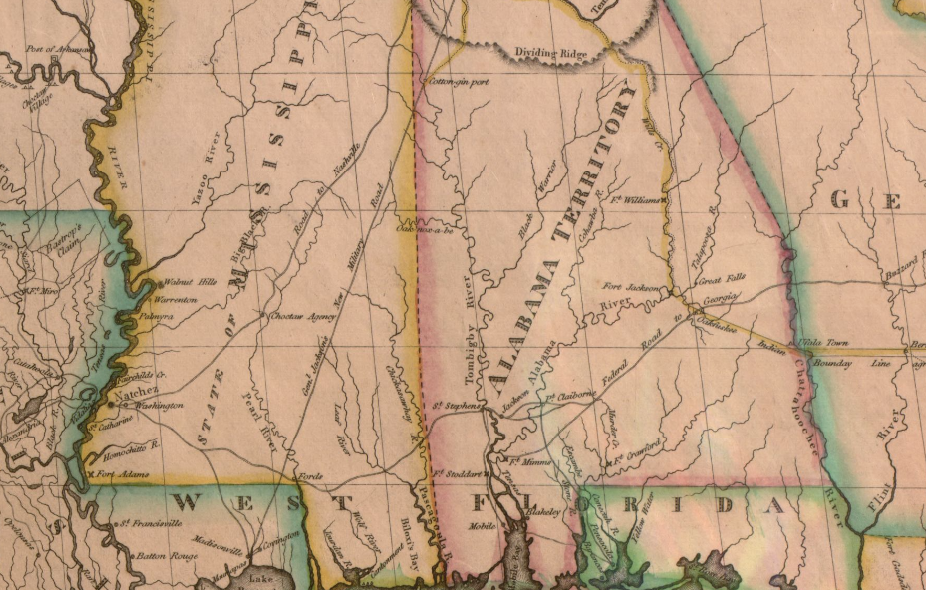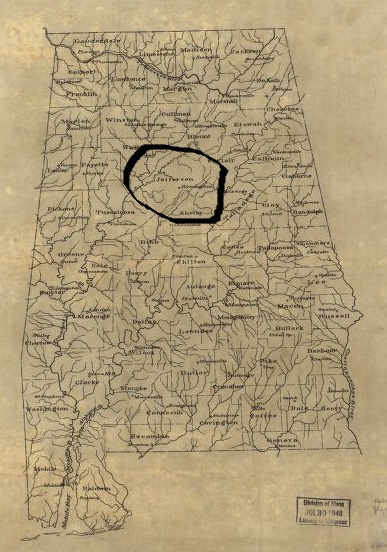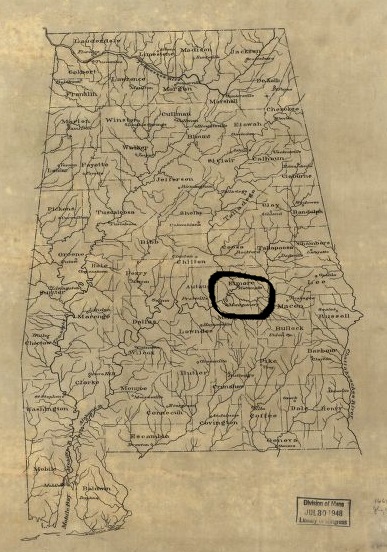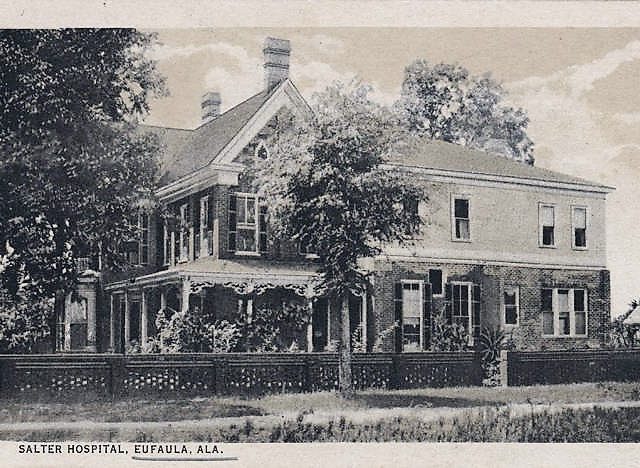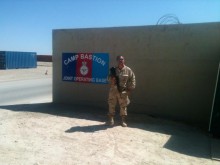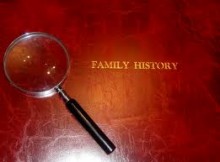A Ruse Saved Immigrants Lives While Traveling Through Indian Territory
This story is an excerpt from the book ALABAMA FOOTPRINTS Settlement: Lost & Forgotten Stories (Volume 2) continued below….
When war finally broke out between England and France in 1752 the Chickasaws remained true to the English, and Bienville’s successor, the Marquis De Vaudreuil, determined to chastise them. He pursued the route followed by Bienville landed with his army at Cotton Gin Port, marched westward against the Chickasaw villages, but he was beaten as disastrously as his predecessor had been. He returned to Mobile with no laurels.
1819 Map by John L. Narstin shows Tombigbee River to the left boundary of Alabama Territory with Cotton Gin Port at top and Mobile at the bottom. (Library of Congress)
At the conclusion of the French and Indian war, by treaty of February 18, 1763, France ceded to Great Britain all of her Canadian possessions and all of Louisiana lying on the eastern side of the Mississippi, as far south as Bayou Iberville. She ceded also the port and river of Mobile.
Spain, the ally of France, ceded to Great Britain her province of Florida. The northern boundary of West Florida was declared to be the line 32 degrees, 28 minutes, which, commencing at the mouth of the Yazoo river, extended through points near the towns of Demopolis on the Tombigbee, and of Columbus on the Chattahoochee. Alabama, south of that line, was in British West Florida; and Alabama, north of that line, was in British Illinois.
As soon as the fertile lands of Alabama and Mississippi passed into English hands, and a British Governor was stationed at Mobile, Anglo-American colonies sprang up in every direction.
A colony of North Carolinians settled between Manchac and Baton Rouge. Virginians came down the Ohio and the Tennessee. Many immigrants came in from England, Ireland, Scotland and the British West Indies.
All along the Mississippi and covering a belt of fifteen miles; settled adventurers from New Jersey, Delaware, and Virginia, and colonies of Scots and of Germans, many of whom assumed French names. The British government industriously supplied early settlers with African slaves.
Trips across the wilds of early Alabama were not without peril. In 1781, a party of Americans from about Natchez, Mississippi, numbering about one hundred men, women, and children, led by Colonel Hutchins, came to the Native American town of Hickory Ground. They sympathized with the British and were in danger about Natchez because the opposers of British rule had obtained the ascendency there. The party was trying to make their way to Savannah, Georgia and had wandered at times much out of the way.
1893 Map of Alabama showing area of Birmingham
When they reached the vicinity of where Birmingham, Alabama now stands, they became afraid to venture among the Cherokee Indians, and turning from the mountains southeasterly, made their way toward the Native American town of Hickory Ground where Wetumpka now stands.
1893 Map showing area of Wetumpka, Elmore County, Alabama
One of the party was a Mrs. Dwight, who on at least two occasions during their trip, had proved herself quite a heroine. They came to the Coosa River about twenty miles above Hickory Ground and hesitated about what to do.
Mrs. Dwight urged upon them to cross the river and pursue their way, and leading herself, they crossed partly by fording and partly by swimming. When they came to the town, the Trading Post Agent, McGillivray, was away. The Indians took them for a party of Georgians who they hated and threatened to destroy them. The party begged earnestly for mercy and disclaimed being Georgians. They told the Indians their story of escape from, Natchez, and their efforts to reach the English at Savannah.
The Indians, intent on their destruction, would have accomplished it but for a ruse practiced by a smart African-American body servant of McGillivray, named Paro, who was present. The Indians told the party they would not believe their story unless they ”could make the paper talk,” that is, by a written statement.
Since Paro could speak English, he listened to their story. Getting some paper from one of the Hutchins party, he pretended to read from it the story of their flight, how they had suffered, and were then badly bruised up and worn out, and were only trying to reach their own people.
When the Indians heard the paper talk corroborating what had been said, they gladly received them, fed them, and cared for them until rested and refreshed. And they were permitted again to go on their way.
ALABAMA FOOTPRINTS – Settlement:: Lost & Forgotten Stories (Volume 2)
Alabama Footprints: Settlement is a collection of lost and forgotten stories of the first surveyors, traders, and early settlements of what would become the future state of Alabama.
Read about:
A Russian princess settling in early Alabama
How the early settlers traveled to Alabama and the risks they took
A ruse that saved immigrants lives while traveling through Native American Territory
Alliances formed with the Native Americans
How an independent republic, separate from the United States was almost formed in Alabama
ALABAMA FOOTPRINTS – Settlement: Lost & Forgotten Stories (Volume 2)


